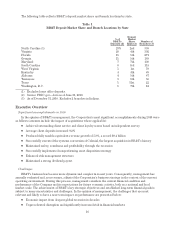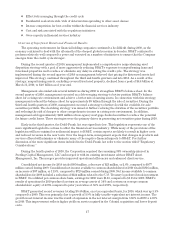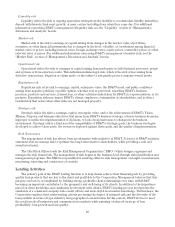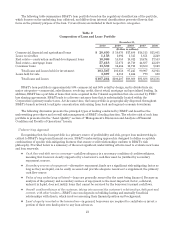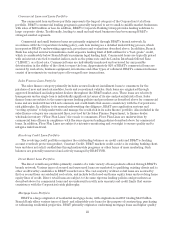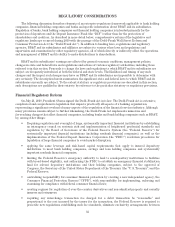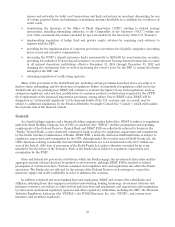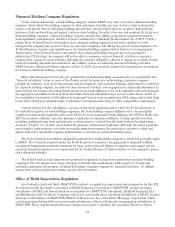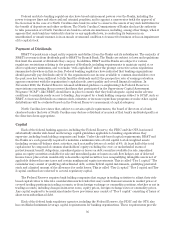BB&T 2010 Annual Report Download - page 26
Download and view the complete annual report
Please find page 26 of the 2010 BB&T annual report below. You can navigate through the pages in the report by either clicking on the pages listed below, or by using the keyword search tool below to find specific information within the annual report.
Commercial
The vast majority of loans in the commercial lending portfolio are assigned a “risk grade” at origination by
the account officer and the assigned risk grade is subsequently reviewed and finalized by a credit officer. Credit
Risk Review, a department that is independent of the loan administration functions, validates the risk grades of
selected relationships through their loan review process. Loans are assigned risk grades based on an assessment
of conditions that affect the borrower’s ability to meet contractual obligations under the loan agreement. This
process includes reviewing borrowers’ financial information, historical payment experience, credit
documentation, public information, and other information specific to each borrower. Risk grades are reviewed on
an annual basis for all credit relationships with total credit exposure of $1 million or more, or at any point
management becomes aware of information affecting the borrower’s ability to fulfill their obligations. For
commercial clients where total credit exposure is less than $1 million, BB&T has developed an automated loan
review system to identify and proactively manage accounts with a higher risk of loss. The “score” produced by
this automated system is updated monthly.
BB&T’s internal risk ratings were correlated with Moody’s bond ratings by mapping the historical default
rates by internal risk grade to those implied in the bond ratings. Investment grade includes all loans mapped to a
“Baa” or higher rating. Near investment grade includes all loans mapped to a “Ba” rating. Noninvestment grade
includes all loans mapped to a “B” or lower rating. BB&T’s commercial loan portfolio is predominately near- and
non-investment grade because investment grade borrowers can access well developed capital markets
alternatives to bank loans, including bonds and commercial paper. In addition, BB&T’s loan mix reflects our
community banking focus, which results in a customer base comprising predominately small and private
businesses. Because BB&T lends mostly to smaller businesses, the portfolio is very granular, with minimal
individual name concentration. In contrast to most investment grade lending, BB&T is a secured lender and the
vast majority of loans are well collateralized, which typically results in lower losses if a default occurs. Finally,
the current mix reflects incomplete recovery from a heavily stressed economic environment.
On a quarterly basis, BB&T reviews all commercial lending relationships with outstanding debt of $2 million
or more that have been classified as substandard or doubtful. While this review is largely focused on the
borrower’s ability to repay the loan, BB&T also considers the capacity and willingness of a loan’s guarantors to
support the debt service on the loan as a secondary source of repayment. When a guarantor exhibits the
documented capacity and willingness to support the loan, BB&T may consider extending the loan maturity and/or
temporarily deferring principal payments if the ultimate collection of both principal and interest is not in
question. In these cases, BB&T may not deem the loan to be impaired due to the documented capacity and
willingness of the guarantor to repay the loan. Loans are considered impaired when the borrower (or guarantor in
certain circumstances) does not have the cash flow capacity or willingness to service the debt according to
contractual terms, or it does not appear reasonable to assume that the borrower will continue to pay according to
the contractual agreement. BB&T establishes a specific reserve for each loan that has been deemed impaired
based on the criteria outlined above. The amount of the reserve is based on the present value of expected cash
flows discounted at the loan’s effective interest rate, and/or the value of collateral. BB&T has also established a
review process related to loans that have been deemed impaired based on their classification as a troubled debt
restructuring (“restructuring”) and other impaired loans that are in commercial lending relationships with an
outstanding debt of less than $2 million at the balance sheet date. In connection with this process, BB&T
establishes reserves related to these loans that are calculated using an expected cash flow approach.
BB&T also maintains reserves for collective impairment that reflect an estimate of losses related to
nonimpaired commercial loans as of the balance sheet date. Embedded loss estimates for BB&T’s commercial loan
portfolio are based on estimated migration rates, which are estimated based on historical experience, and current
risk mix as indicated by the risk grading process described above. Embedded loss estimates may be adjusted to
reflect current economic conditions and current portfolio trends including credit quality, concentrations, aging of
the portfolio, and significant policy and underwriting changes.
Retail
The majority of the allowance for loan and lease losses related to the retail lending portfolio is calculated on a
collective basis using a delinquency-based approach. Embedded loss estimates for BB&T’s retail lending portfolio
are based on estimated migration rates that are developed based on historical experience, and current risk mix as
26


